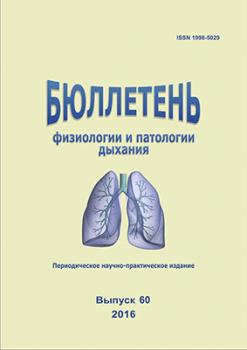Blagoveschensk, Blagoveshchensk, Russian Federation
Blagoveschensk, Blagoveshchensk, Russian Federation
Blagoveschensk, Blagoveshchensk, Russian Federation
Blagoveschensk, Blagoveshchensk, Russian Federation
Chronobiological aspects of blood gas composition in 24 patients with COPD were studied. To achieve this goal, the gas composition of the arterialized capillary blood simultaneously with the investigation of respiratory function was studied with an interval of 6 hours over 2 days. In healthy individuals and patients with mild COPD two types of gas composition of blood biorhythm – daytime and nighttime – were found. In patients with moderate, severe and very severe disease 3 types of biorhythm of partial oxygen and carbon dioxide tension – morning time, noontime and evening time were registered. In healthy individuals and patients with mild COPD gas composition of blood was characterized by significant degrees of freedom in relation to functioning of the respiratory system, which indicated the stored processes of adaptation to changing conditions of the external and internal environment. In patients with moderate, severe and very severe COPD at the moment of acrophase of circadian rhythm of lung function maximum partial oxygen pressure in the arterialized capillary blood was observed. During the batiphaze of circadian rhythm of the respiratory system the highest values of the partial carbon dioxide tension were revealed. Thus, it was found out that with the growth of the severity of the disease in patients with COPD abnormal rhythms of blood gas composition are registered; the dependence of circadian rhythm of blood gas composition on the functioning of the respiratory apparatus increases.
chronic obstructive pulmonary disease, blood gas, types of biorhythms of the respiratory system and blood gas.
1. Bardov V.S., Prikhodko O.B. Immunotherapy of respiratory infections in patients with COPD. Allergologiya i immunologiya 2014; 15(1):40 (in Russian).
2. Voytsekhovskiy V.V., Landyshev Y.S., Grigorenko A.A., Savinova T.A., Goryacheva S.A. Features of chronic obstructive pulmonary disease associated with multiple myeloma. Bûlleten´ fiziologii i patologii dyhaniâ 2013; 49:59-64 (in Russian).
3. Kostrova I.V., Prikhodko O.B. The use of tiotropium bromide in patients with chronic obstructive pulmonary disease, considering the circadian rhythms of breath. In: Proceedings of the VI conference of pulmonologists of Siberia and Far East. Blagoveshchensk; 2015: 94-97 (in Russian).
4. Kolosov V.P., Trofimova A.Yu., Naryshkina S.V. Quality of life in patients with chronic obstructive pulmonary disease. Blagoveshchensk; 2011 (in Russian).
5. Lutsenko M.T., Perelman J.M., Kolosov V.P., Pirogov A.B., Odireev A.N., Samsonov V.P. The mechanisms of pathogenesis and trends of correction of non-specific lung diseases. Vol.1. Blagoveshchensk; 2005 (in Russian).
6. Pronina E.Yu. Top of the iceberg - epidemiology of COPD (Literature overview). Vestnik sovremennoy klinicheskoy meditsiny 2011; 4(3):18-23 (in Russian).
7. Kolosov V.P., Kolosov А.V. Patent 2240725 RU. Method for predicting the progress in respiratory tract obstruction; published 27.11.2004 (in Russian).
8. Chuchalin A.G., editor. Chronic obstructive pulmonary disease. Moscow: Atmosfera; 2008 (in Russian).
9. Kostrova I.V., Prikhodko O.B., Goryacheva S.A. Effect of tiotropium bromide on external respiration function of patients with chronic obstructive pulmonary disease, taking into account circadian rhythms of breath. In: Proceedings of the XII Russian-Chinese biomedical forum “Innovative treatment methods in traditional Russian and Chinese medicine”. Amur Medical Journal 2015; 2:124-127.





